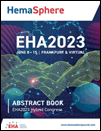P600: DNA METHYLATION ANALYSIS OF B-CELL PROLYMPHOCYTIC LEUKEMIA REVEALS TWO EPIGENETIC SUBTYPES WITH DISTINCT BIOLOGICAL AND CLINICAL FEATURES
Background: B-cell prolymphocytic leukemia (B-PLL) is a very rare and aggressive mature lymphoid disorder whose differential diagnosis with other B-cell diseases such as chronic lymphocytic leukemia (CLL) and marginal zone lymphoma (MZL) remains challenging. Currently, whether B-PLL should be recognized as a separate entity is a matter of debate based on the most recent ICC and WHO classifications.
Aims: The aim of this study was to characterize the DNA methylome of B-PLL in the context of CLL, MZL, and mantle cell lymphoma (MCL) to better understand B-PLL pathobiology.
Methods: We generated DNA methylation data with Illumina EPIC arrays from a highly curated B-PLL cohort (n=21), in which the presence of any translocation involving CCND1, CCND2 and CCND3 was ruled out in all the patients (Chapiro, 2019). We also used previous EPIC data, including 78 CLL, 70 MCL, and 19 MZL cases, as well as 7 normal sorted B cell subpopulations (2 naive B cells, 1 germinal-center B cells, 3 memory B cells, 2 plasma cells). Differential methylation analyses were performed using limma. Chromatin segmentation of GM12878 cell line was used to study regulatory regions. Whole exome sequencing (n=18) was used to study genetic alterations and the IGH locus. RNA-seq data (n=12) was used for differential expression analyses and gene set enrichment analyses. Genetic and clinical associations were tested using two-tailed Fisher test and the log-rank test, respectively.
Results: An unsupervised principal component analysis (PCA) showed that the B-PLL DNA methylome was heterogeneous, with cases scattered across CLL and MCL clusters but separated from MZL cases. In line with this, although we identified 5,123 and 2,267 differential CpGs in B-PLL vs CLL and MCL, respectively, we could not identify any clear signature that differentiates B-PLL from both entities. Despite of the heterogeneity within B-PLL, we could identify clearly two subgroups. A group of 6 B-PLL cases clustered with conventional MCL cases and were termed epitype 1 B-PLLs, while the other 14 cases overlapped with all CLLs and leukemic non-nodal MCL and were termed epitype 2 B-PLLs. One case could not be assigned to any group. We identified 5,474 differentially methylated CpGs between the two B-PLL epitypes, of which 828 (15.1%) were also changing during normal B-cell maturation. Overall, these B-cell related CpGs showed a methylation signature consistent with different levels of epigenetic programming during the germinal center reaction, showing epitype 1 B-PLLs a lower programing level than epitype 2 cases. In line with this, epitype 1 also showed a tendency to lower IGHV somatic hypermutation (mean germline identity 96.45% vs 94.32%, respectively, P=0.08), and lower proliferative history measured by the epiCMIT mitotic clock (P=0.008). Epitype 1 showed a clear de novo hypomethylation signature compared to normal B cells, CLL and MCL, which was enriched in active regulatory regions. This epitype was also enriched in SF3B1 and MYC mutations (P≤0.02), and was associated with gene expression signatures related to MYC signaling (FDR=0.02). Finally, in spite of the low sample size, we observed that epitype 1 cases showed a significantly worse overall survival than epitype 2 cases (P=0.019).
Summary/Conclusion: Our DNA methylation analyses showed that B-PLL is heterogeneous, and cannot be epigenetically classified as CLL, MCL or MZL. Part of this B-PLL heterogeneity may be related to the presence of 2 B-PLL epitypes with potential different cell of origin, genetic mutations, transcriptional profile and clinical outcome.
Keywords: DNA methylation, Lymphoproliferative disorder




